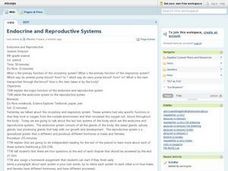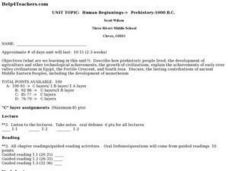Curated OER
Just a "Fellow Traveler" in the Human Experience
Pupils connect the events of early space exploration to their lives today. After viewing a teacher created gallery, they discuss how the launch of Sputnik and how space exploration in general has positively or negatively affected their...
Curated OER
Artifacts 1: What Can We Learn From Artifacts?
Sixth graders are introduced to artifacts and explore an online archaeological site to connect clues about how people once lived. In this deductive reasoning lesson, 6th graders participate in the stratigraphy game on Kids Dig Reed.com...
Curated OER
Bears and Panthers Aplenty: Early Settlers Make a Home in Arkansas
Young historians research the Southwest Trail, which ran through Arkansas back in the 19th century. Pupils are divided into four groups. Each group researches a pioneer who blazed the Southwest Trail. Then, the group presents an oral or...
Curated OER
Revolutions in Latin America (19c - Early 20c)
The history of the Latin American revolutions - and the philosophies behind them - is the focus of this comprehensive presentation. From the theories of the European Enlightenment, to the Revolutionary Wars of America and France, Latin...
Curated OER
Human Genetic Diseases
Although there are a few missing titles in this collection of slides, if your class has the support of a genetic disease lecture to accompany it, this resource will be very useful. The mechanism of genetic inheritance is covered. Flow...
Curated OER
Human Genetic Diseases
Although there are a few missing titles in this collection of slides, if your class has prior knowledge of genetic diseases then this resource could be useful. The mechanism of genetic inheritance are covered and both flow charts and...
Curated OER
Taking Care of a Baby
Students are introduced to the basics of human development and the critical role of parents in taking care of a newborn.
Curated OER
Taking Care of a Baby
Pupils explore the basics of human development and the critical role of parents in taking care of a newborn.
Time Warp Trio
The Caveman Catastrophe
Young archaeologists study the development of human history, and work in groups to create a timeline that traces the development of humans. Additionally, the groups utilize a very clever graphic organizer embedded in the plan in order to...
Curated OER
The Chesapeake Bay in Captain John Smith's Time
When Captain John Smith visited the Chesapeake Bay in the summer of 1608, what types of animals and habitats did he encounter? Your young historians will analyze primary source documents to answer this question, as well as compare the...
Curated OER
Urban Ecosystems 2: Why are There Cities? A Historical Perspective
Second in a series of five lessons, this lesson encourages preteens to consider cities as urban ecosystems. First, they keep a food diary for a few days. They visit the Natrional Agricultural Statistics Service website for current data...
Curated OER
Endocrine And Reproductive Systems
Young scholars investigate the hormonal levels that are created with the endocrine system and tie it to the act of sexual reproduction. The lesson discusses how the respiratory system is organized as a comparison to the endocrine system...
Curated OER
Early Explorers Web Quest
Pupils use the Canadian atlas online to research early explorers and settlers in Canada. They also complete a Web Quest to gather information from maps. They make generalizations about the early settlement patterns as well.
Curated OER
People Grow and Change
In this stages of human development chart, students complete a graphic organizer following the stages of human development from infancy to adulthood. The students creates connections of concepts of human development in a visual...
Curated OER
Scientific and Cultural Advancements of Early China
Seventh graders explore early Chinese civilization. As pupils study Chinese history, they examine its scientific accomplishments. In partners, 7th graders create an advertisement presentation for an advancement of ancient China.
Curated OER
Human Settlement and Movement
Students are introduced to the way humans have settled and moved throughout history. In groups, they compare and contrast the settlement and movement of two different ethnic groups. They discover why some are more dominate in an area...
Curated OER
Human Beginnings-> Prehistory-1000 B.C.
Learners describe how prehistoric people lived, the development of agriculture and other technological achievements, the growth of civilizations, explain the achievements of early river valley civilizations in Egypt, the Fertile...
Curated OER
Cave Painting in the Ice Age
Students take notes and sketch during the Internet research. They take notes of the colors found in the cave paintings (black, browns, ochre, sienna). They create an initial full size comprehensive sketch on scrap paper and in their...
Curated OER
Human Features of Our Community
Students investigate the human factors that create a community. They conduct research using a variety of sources. Students then create dioramas that depict a typical scene found in a community.
Curated OER
The True Confessions of Charlotte Doyle: KWHL
After completing the 11th chapter of The True Confessions of Charlotte Doyle by Avi, take part in a KWHL chart driven by the question,When is it appropriate and admirable to defy authority? Focusing on codes of conduct, scholars...
Curated OER
Comparing Fossils
Students explore early hominid evolution as they analyze bones that share characteristics of both apes and humans. Students compare and contrast key skeletal differences between chimpanzees and humans. In groups, they sort and group a...
Curated OER
Science in History Part I: the Abacus To the Modern Computer
In this math information worksheet, students read one page factual accounts of the early math inventions of the abacus, the calculator and early computers. There are 40 questions to answer about the reading.
Curated OER
Skeleton
Learners study the skeleton. In this human body lesson plan, students draw and label bones in the body by tracing each other and creating a skeleton out of body parts and brass fastners.
Curated OER
Technology in the Early Education Classroom
Learners explore computers. They type their names and use different fonts. They create mini-posters using Kid Pix software and use the Oregon Trail software to discover the westward trek in United States history. They explore websites...
Other popular searches
- Timeline of Early Man
- Early Man Neanderthal
- Time Line of Early Man
- Powerpoint Early Man
- Cultures of Early Humans
- History Early Man
- Social Studies Early Humans
- Early Humans Wanted Poster
- Early Man Rock Art
- Early Humans Africa
- Early Man Africa
- Timelines of Early Man

























